Geological Modeling of Shale Oil in Member 7 of the Yanchang Formation, Heshui South Area, Ordos Basin
Abstract
:1. Introduction
2. Basic Geological Overview
3. Research Methods and Processes
4. Study of Sedimentary Microfacies
5. Establishment of 3D Geological Model
5.1. Structural Model
5.2. Analysis of Variation Function
5.2.1. Geological Probability Surface-Constrained Lithofacies Model
5.2.2. Correlation of Lithofacies Profile
5.3. Reservoir Parameter Model
6. Model Verification
7. Conclusions
Author Contributions
Funding
Institutional Review Board Statement
Informed Consent Statement
Data Availability Statement
Conflicts of Interest
References
- Jin, Z.; Bai, Z.; Gao, B.; Li, M. Has China ushered in the shale oil and Gas revolution? Oil Gas Geol. 2019, 40, 451–458. [Google Scholar]
- Zou, C.; Zhu, R.; Bai, B.; Yang, Z.; Hou, L.; Zha, M.; Fu, J.; Shao, Y.; Liu, K. Connotation, characteristics, potential and challenges of tight oil and shale oil. Bull. Mineral. Petrol. Geochem. 2015, 34, 3–16. [Google Scholar]
- Jia, C.; Zheng, M.; Zhang, Y. Important theoretical Issues in unconventional oil and gas geology. Acta Pet. Sin. 2014, 35, 1–10. [Google Scholar]
- Jia, C. Breakthrough and significance of unconventional oil and gas to classical petroleum geological theory. Pet. Explor. Dev. 2017, 44, 1–11. [Google Scholar] [CrossRef]
- Yang, Z.; Zou, C. “Oil exploration into source rock”: Connotation and prospect of source rock oil and gas. Pet. Explor. Dev. 2019, 46, 1–12. [Google Scholar] [CrossRef]
- Zou, C.; Yang, Z.; Zhang, G.; Hou, L.; Zhu, R.; Tao, S.; Yuan, X.; Dong, D.; Wang, Y.; Guo, Q.; et al. Theoretical understanding and practical significance of orderly accumulation of conventional and unconventional oil and gas. Pet. Explor. Dev. 2014, 41, 14–27. [Google Scholar] [CrossRef]
- Li, J.; Wu, B.; Zhao, H.; Cheng, N.; Huang, J. Adaptability analysis of horizontal well volume fracturing technology in Mahu tight conglomerate reservoir. China Pet. Explor. 2019, 24, 250–259. [Google Scholar]
- Zhang, Q.; Li, M.; Zhang, Z.; Chen, Y.; Zhang, L.; Li, A. Application of volume fracturing technology and application of tight oil reservoir in Shengli Oilfield. China Pet. Explor. 2019, 24, 233–240. [Google Scholar]
- Mu, L.; Zhao, Z.; Li, X.; Zhang, J.; Tang, M.; Du, X.; Bai, X. Fine cut volumetric fracturing technology for shale oil horizontal Wells in Ordos Basin. Oil Gas Geol. 2019, 40, 626–635. (In Chinese) [Google Scholar]
- Shi, D.; Zhang, B.; He, J.; Jiang, T.; Pu, C. Feasibility evaluation of volumetric fracturing of Chang 7 tight sandstone reservoir in Ordos Basin. J. Xi’an Shiyou Univ. Nat. Sci. Ed. 2014, 29, 52–55. [Google Scholar]
- Jin, C.; He, J.; Lin, Q.; Mei, J.; Duan, Y. Fracturing stimulation based on geology-engineering integration to tight oil reservoirs in Block Fang 19833northern Songliao Basin. China Pet. Explor. 2019, 24, 218–225. [Google Scholar]
- Bai, X.; Qi, Y.; Lu, H.; Duan, P.; Gu, Y.; Wu, F. Optimization design for volume fracturing of horizontal wells in tight oil reservoir of Ordos Basin. Oil Drill. Prod. Technol. 2015, 37, 83–86. [Google Scholar]
- Niu, X.; Feng, S.; You, Y.; Liang, X.; Xin, H.; Dan, W.; Li, Y.; Ren, J. Fracture extension and distribution pattem of volume fracturing in tight reservoir:an analysis based on actual coring data after fracturing. Oil Gas Geol. 2019, 40, 669–677. [Google Scholar]
- Niu, X.; Feng, S.; You, Y.; Liang, X.; Wang, F.; Li, W.; Hao, B. Practice and experience in geological research and test of tight oil in Ordos Basin. Oil Forum 2016, 35, 38–45. [Google Scholar]
- Zhang, J.; Lin, L.; Li, Y.; Tang, X.; Zhu, L.; Xing, Y.; Jiang, S.; Jin, T.; Yang, S. Classification and evaluation of shale oil. Earth Sci. Front. 2012, 19, 322–331. [Google Scholar]
- Niu, X.; Feng, S.; Liu, F.; Wang, C.; Zheng, Q.; Yang, X.; You, Y. Microscopic occurrence of oil in tight sandstones and its relation with oil sources a case study from the Upper Triassic Yanchang Formation, Ordos Basin. Oil Gas Geol. 2013, 34, 288–293. [Google Scholar]
- Yao, J.; Deng, X.; Zhao, Y.; Han, T.; Chu, M.; Pang, J. Characteristics of tight oil in Triassic Yanchang Formation, Ordos Basin. Pet. Explor. Dev. 2013, 40, 150–158. [Google Scholar] [CrossRef]
- You, Y.; Niu, X.; Feng, S.; Wang, F.; Wang, C.; Li, W. Study of pore features in Chang 7 tight oil reservoir, Yanchang layer, Ordos Basin. J. China Univ. Pet. Ed. Nat. Sci. 2014, 38, 18–23. [Google Scholar]
- Li, X.; Fan, F.; Yang, H.; Zhang, Y.; Ma, B. Volumetric fracturing technology of low-pressure tight oil reservoirs horizontal wells under different development conditions in Ordos Basin. Oil Drill. Prod. Technol. 2016, 39, 34–36. [Google Scholar]
- Zou, C.; Ding, Y.; Lu, Y.; Liu, X.; Chen, J.; Wang, X.; Yang, Z.; Cai, B.; Yang, Z.; He, C.; et al. Concept, technology and practice of “man-made reservoirs” development. Pet. Explor. Dev. 2017, 44, 144–154. [Google Scholar] [CrossRef]
- Pang, J.; Dan, W.; Sun, B.; Deng, J.; Shi, Z. The microscopic reservoir features of tight oil in Chang 7 reservoir of Longdong Chenghao area in Ordos Basin. J. Oil Gas Technol. 2015, 37, 1–6. [Google Scholar]
- Yang, H.; Niu, X.; Luo, S.; Feng, S.; Lv, Q. Research of simulated experiment on gravity flow deposits of tight sand bodies of Chang7 Formation in Longdong area, Ordos Basin. Earth Sci. Front. 2014, 21, 322–332. [Google Scholar]
- Zhou, Q.; Jin, Z.; Yang, G.; Dong, N.; Shang, Z. Shale oil exploration and production in the U.S.: Status and outlook. Oil Gas Geol. 2019, 40, 469–477. [Google Scholar]
- Zhang, L.; Li, J.; Li, Z.; Zhang, J.; Zhu, R.; Bao, Y. Advances in shale oil/gas research in North America and considerations on exploration for continental shale oil/gas in China. Adv. Earth Sci. 2014, 29, 700–711. [Google Scholar]
- Jia, C.; Zheng, M.; Zhang, Y. Unconventional hydrocarbon resource in China and the prospect of exploration and development. Pet. Explor. Dev. 2012, 39, 129–136. [Google Scholar] [CrossRef]
- Hu, W. Development and potential of unconventional oil and gas resources in China national petroleum corporation. Nat. Gas Ind. 2008, 28, 5–7. [Google Scholar]
- Pu, X.; Jin, F.; Han, W.; Shi, Z.; Cai, A.; Wang, A.; Guan, Q.; Jiang, W.; Zhang, W. Geological characteristics and key exploration technologies of continental shale oil dessert: A case study of the second member of Kongdian Formation in Cangdong Sag. Acta Pet. Sin. 2019, 40, 997–1012. [Google Scholar]
- Wang, X.; Yang, Z.; Guo, X.; Wang, X.; Feng, Y.; Huang, L. Shale oil exploration practice and prospect in Jimsar Sag, Junggar Basin. Xinjiang Pet. Geol. 2019, 40, 402–413. [Google Scholar]
- Zhou, L.; Chen, C.; Han, G.; Yang, F.; Ma, J.; Zhou, K.; Zhang, W.; Huang, C. Geological characteristics and shale oil exploration potential of Shaxia sub-member in Qikou Sag, Bohai Bay Basin. Earth Sci. 2019, 44, 2736–2750. [Google Scholar]
- Liang, S.; Luo, Q.; Wang, R.; Chen, X.; Yang, B.; Ma, Q.; Liang, H. Geological characteristics and exploration practice of Permian unconventional petroleum in Santanghu Basin. China Pet. Explor. 2019, 24, 624–635. [Google Scholar]
- Yang, Z.; Hou, L.; Lin, S.; Luo, X.; Zhang, L.; Wu, S.; Cui, J. Geological characteristics and exploration potential of tight oil and shale oil in Lusaogou Formation, Jimsar Sag. China Pet. Explor. 2018, 23, 76–85. [Google Scholar]
- Du, J.; Hu, S.; Pang, Z.; Lin, S.; Hou, L.; Zhu, R. Types, potential and prospect of continental shale oil in China. China Pet. Explor. 2019, 24, 560–568. [Google Scholar]
- Guo, J.; Wang, J.; Meng, F. Promoting the high-quality development of China’s shale oil upstream industry by following international first-class standard. China Pet. Explor. 2019, 24, 547–552. [Google Scholar]
- Zou, C.; Yang, Z.; Wang, H.; Dong, D.; Liu, H.; Shi, Z.; Zhang, B.; Sun, S.; Liu, D.; Li, G.; et al. “Exploring petroleum inside source kitchen”: Jurassic unconventional continental giant shale oil & gas field in Sichuan basin, China. Acta Geol. Sin. 2019, 93, 1551–1562. [Google Scholar]
- Fu, J.; Li, S.; Hou, Y.; Zhou, X.; Liu, J.; Li, S. Risk exploration breakthrough of Class II shale oil in Member 7 of Yanchang Formation, Ordos Basin and its significance. China Pet. Explor. 2020, 25, 78–92. [Google Scholar]
- Shao, X.; Wang, M.; Qi, Y.; He, T.; Zhang, X.; Pang, J.; Guo, Y. Characteristics and main controlling factors of Chang 8 reservoir in northern Pingliang area, Ordos Basin. Lithol. Reserv. 2021, 33, 59–69. [Google Scholar]
- Pu, B.; Wang, F.; Wang, K.; Sun, J.; Li, Y.; Shi, B.; Zhao, W.; Guo, X. Shale gas accumulation and enrichment conditions and development model of Chang 7 Member in Yan’an area. Geol. China 2023, 50, 1285–1298. [Google Scholar]
- PetrelTM, version 2018; Schlumberger Software Co.: Houston, TX, USA, 1927. Available online: https://www.slb-sis.com.cn/(accessed on 12 May 2024).
- Wang, J. Research on Reservoir Inter Layer Model. Master’s Thesis, China University of Petroleum, Qingdao, China, 2010. [Google Scholar]
- Cong, S.; Zhou, H.; Zhao, Y.; Jin, H.; Liu, P.; Wu, R.; Chen, Y. Study on 3D geological modeling technology of Shenshui 501 geothermal field in Damintun Depression. Oil Gas Reserv. Eval. Dev. 2023, 13, 741–748. [Google Scholar] [CrossRef]
- Zhang, R.; Wen, Q.; Ye, L.; Zhang, H.; Wang, J. Application of 3D geological modeling software in domestic mineral resources development. Sichuan Nonferr. Met. 2021, 4, 12–14. [Google Scholar]
- Huang, C.; Jiang, K.; Li, L.; Li, C.; Zeng, F.; He, Q. Research progress of three-dimensional geological modeling of mines. J. Sichuan Geol. 2020, 40, 323–326. [Google Scholar]
- Zhang, P.; Zhang, C.; Liu, X.; Li, J.; Du, K. Big LuGou two district 6 JingAn oilfield reservoir geological model. J. Reserv. Eval. Dev. 2016, 6, 1–6. [Google Scholar] [CrossRef]
- Cao, J.; Wang, X.; Fan, L.; Yuan, X.; Wei, F. Deep water tight sandstone reservoir characteristics and diagenetic facies analysis: A case study of Chang 7 oil-bearing formation in Xifengarea, Ordos Basin, NW China. J. Northwest Univ. Nat. Sci. Ed. 2021, 51, 80–94. [Google Scholar]
- Li, S.; Zhang, C.; Lin, K.; Yin, T.; Zhang, C. Establishment of several prototype models in reservoir modeling. Sediment. Tethys Geol. 2004, 24, 102–107. [Google Scholar]
- Xu, K. Comparative analysis of stochastic modeling and deterministic modeling of sedimentary facies. Inn. Mong. Petrochem. Ind. 2019, 46, 114–117. [Google Scholar]

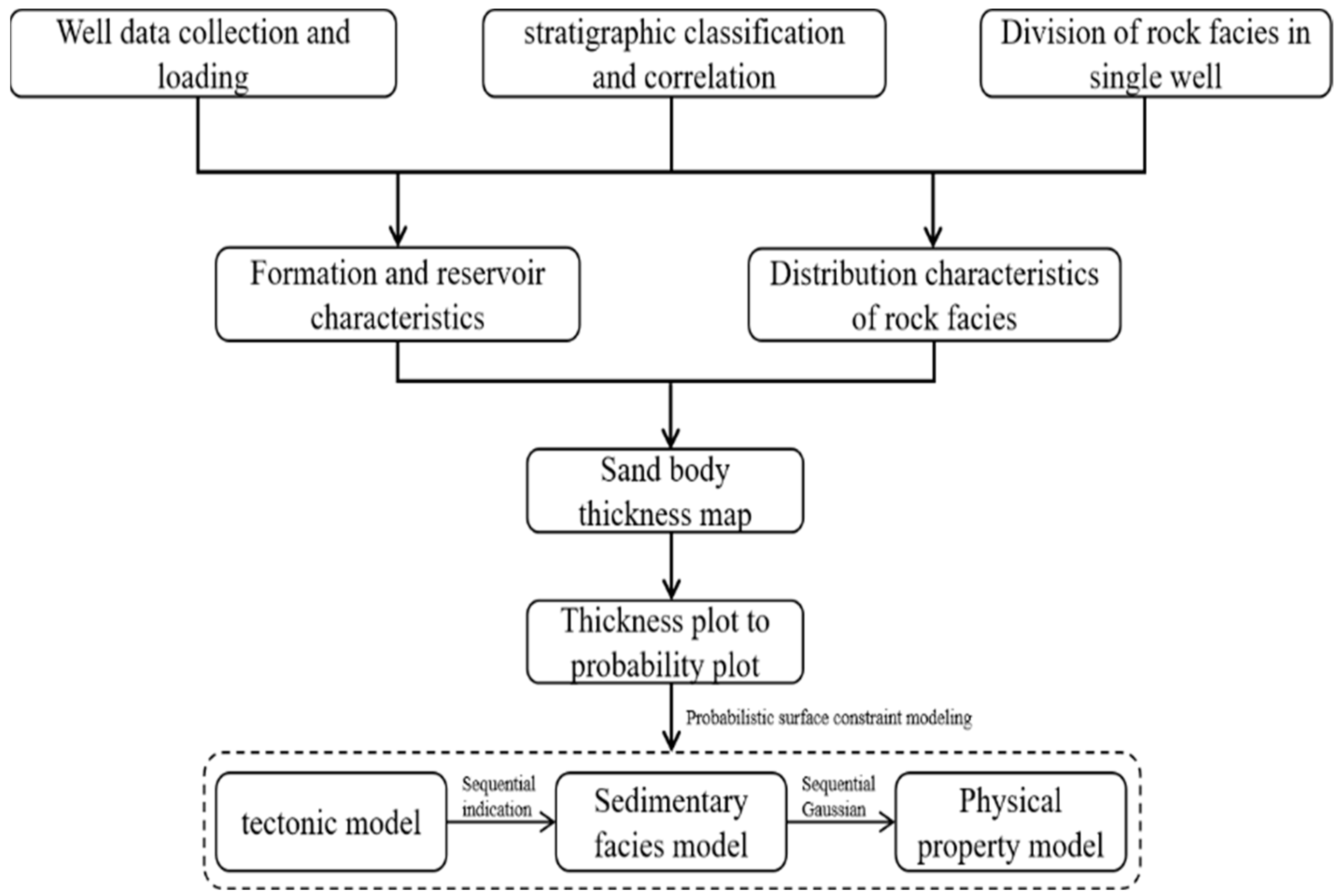

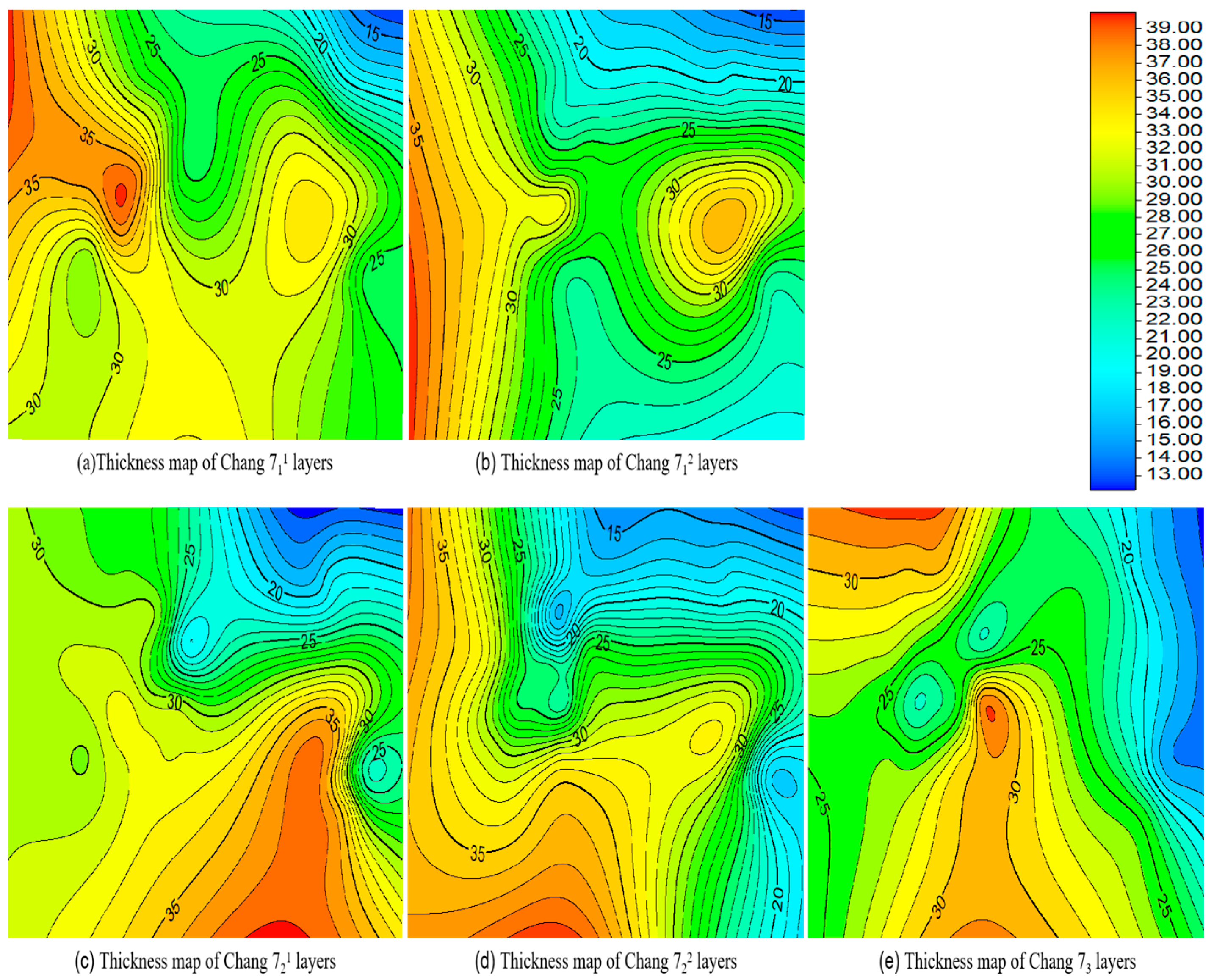
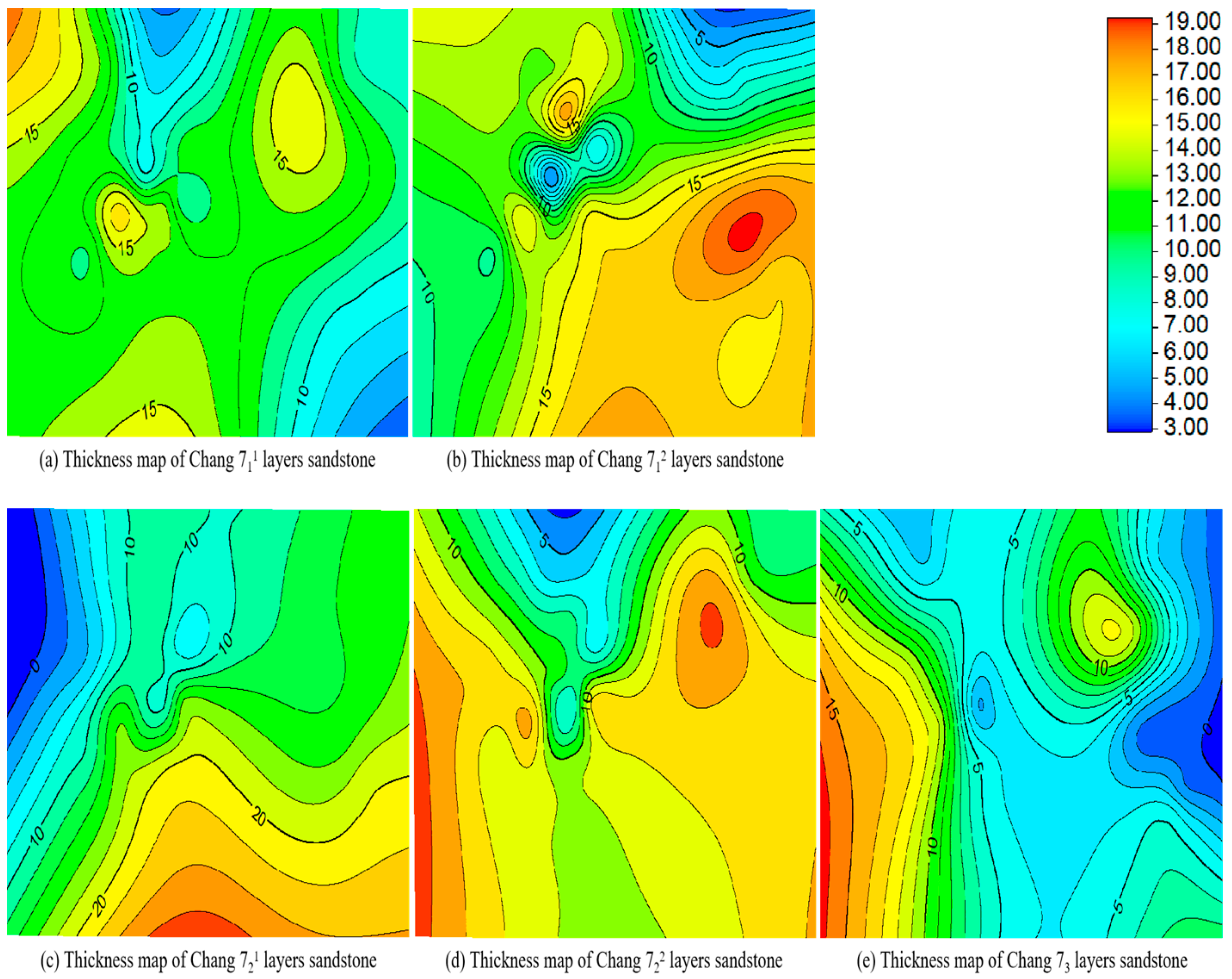

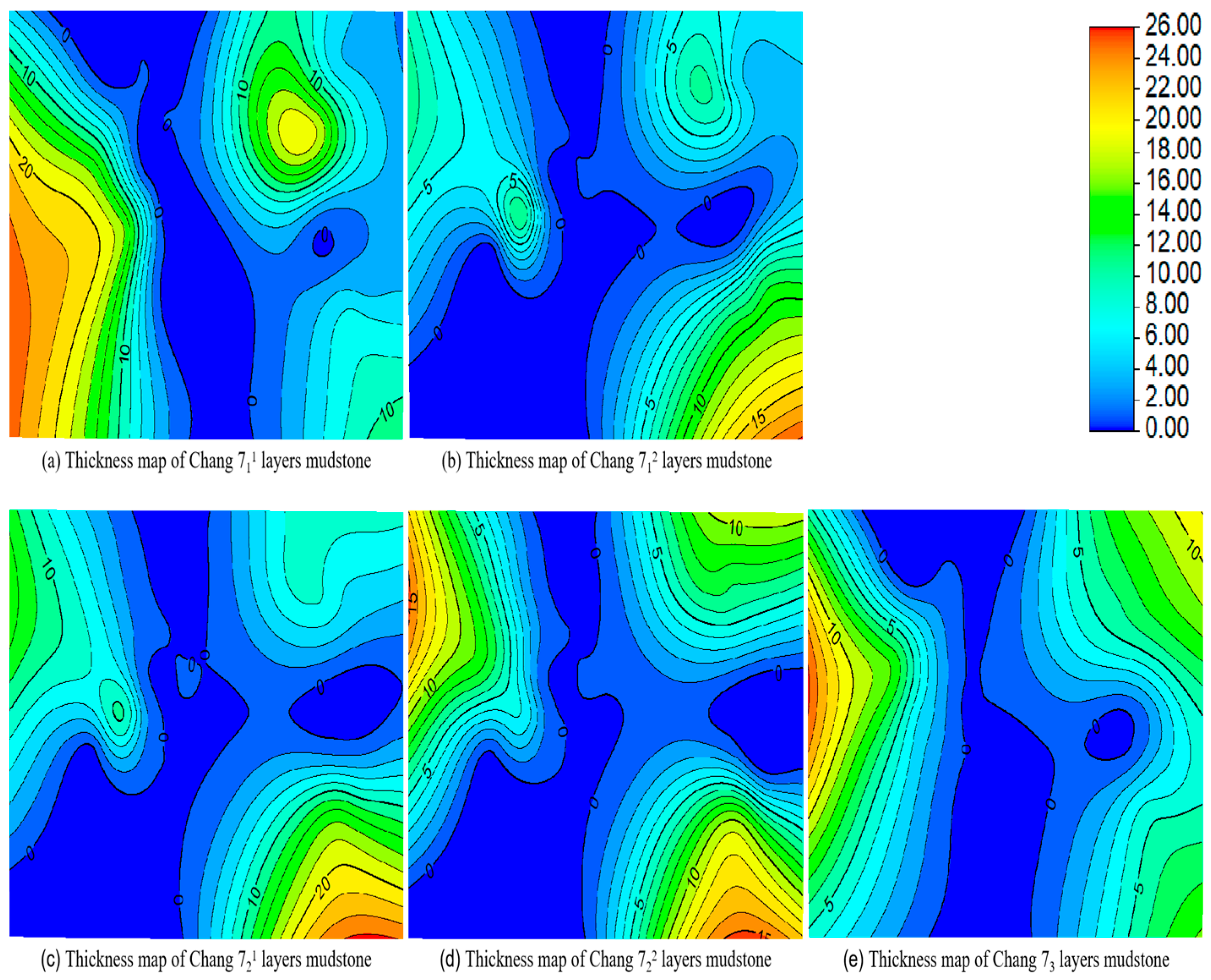

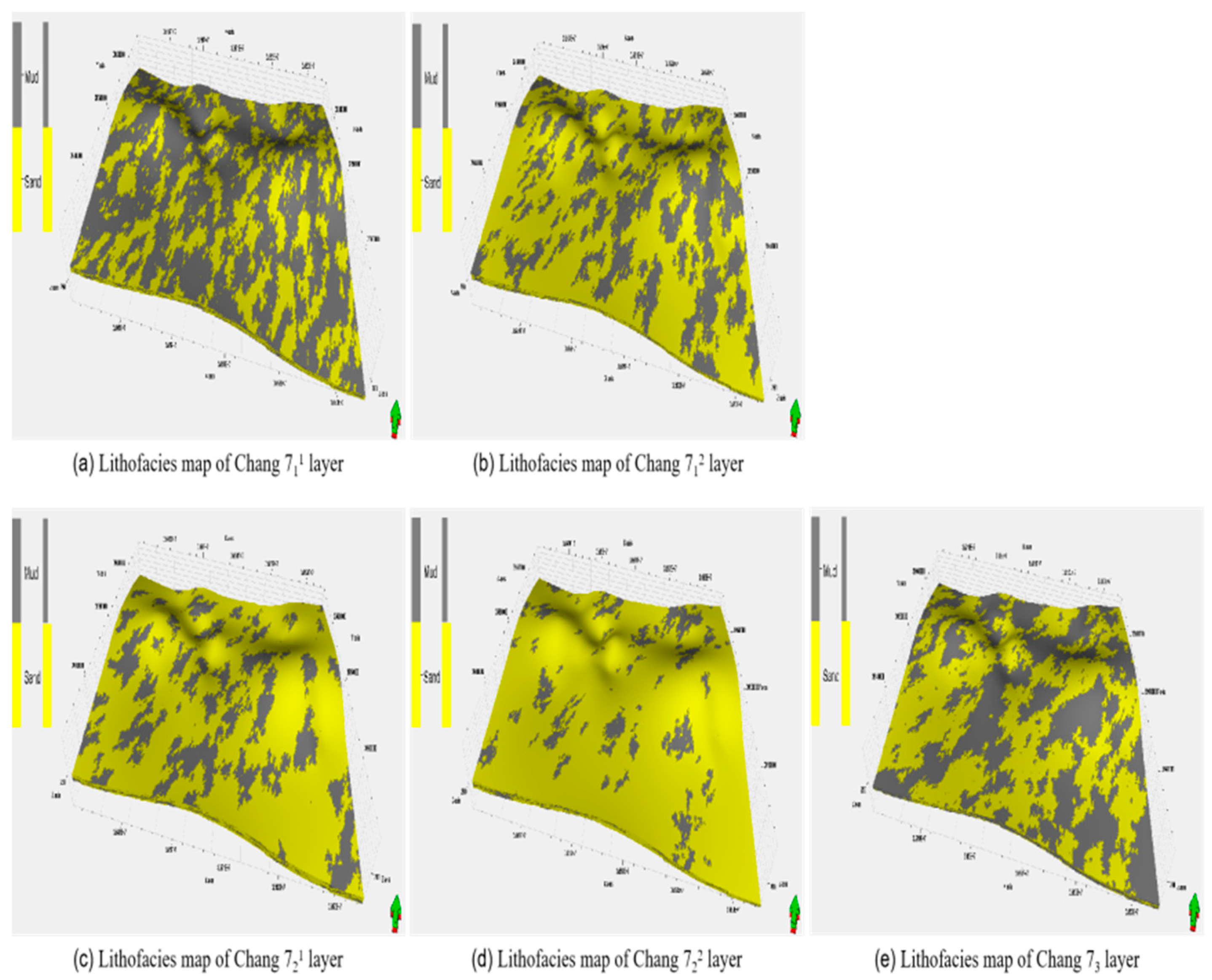
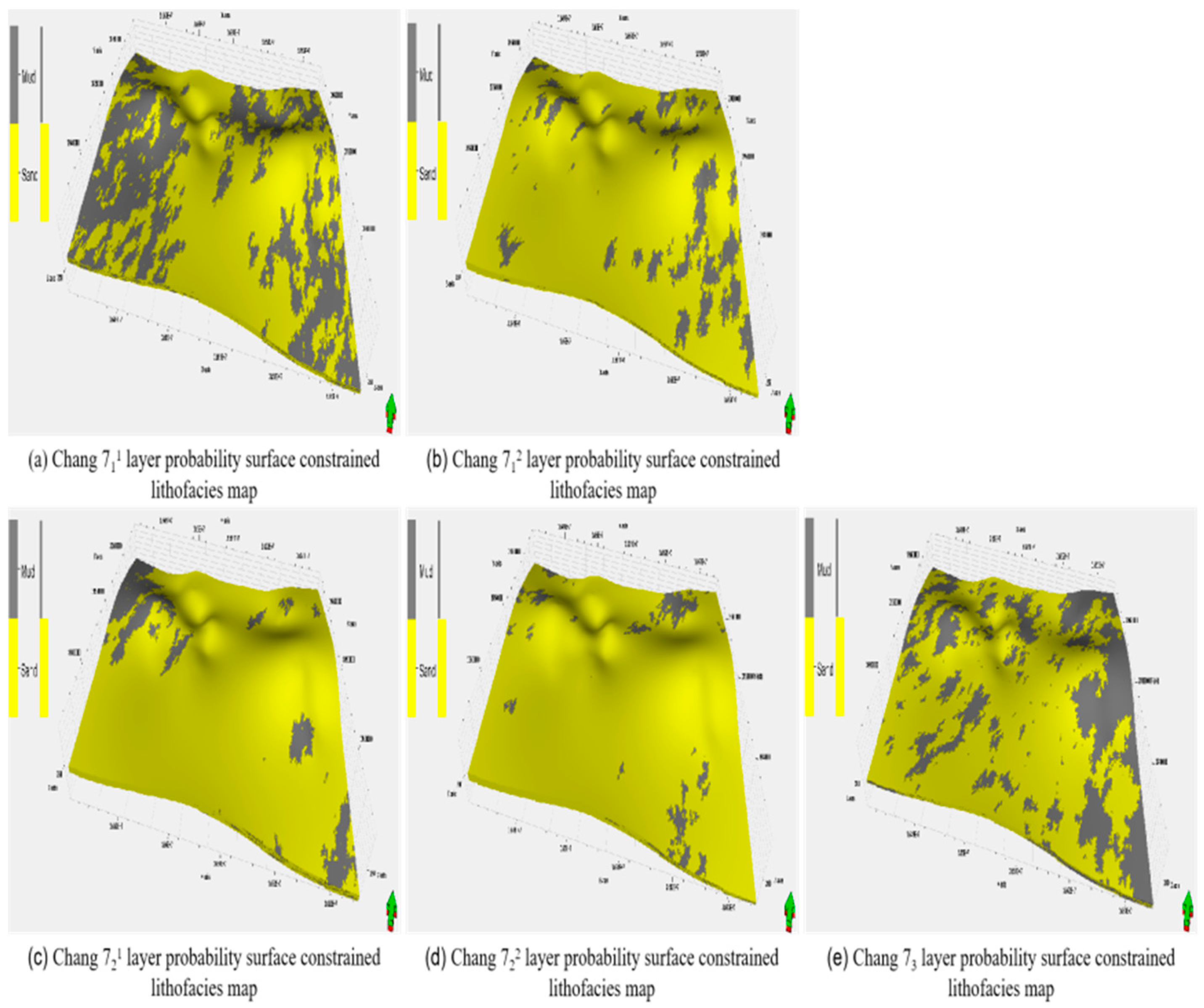
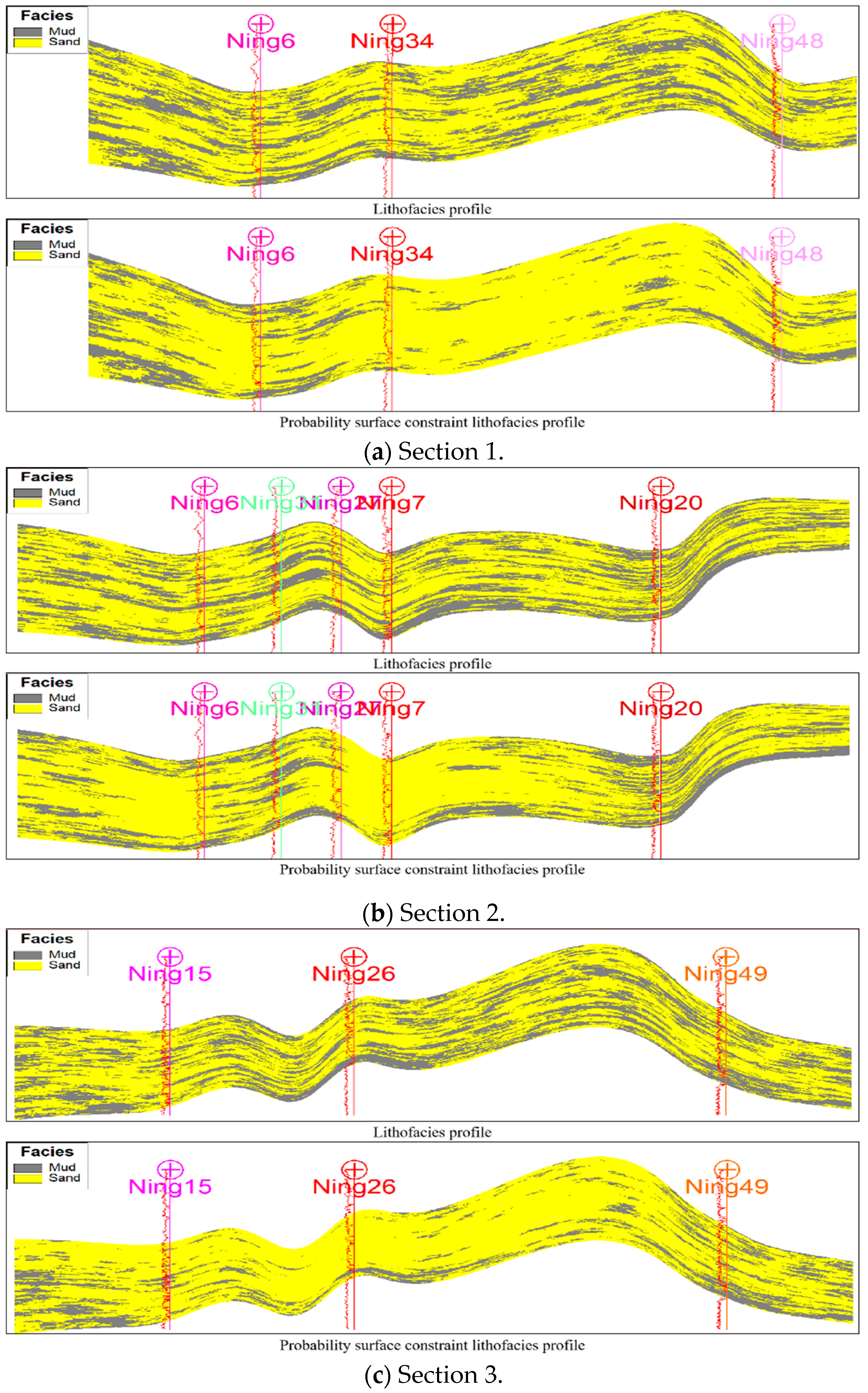
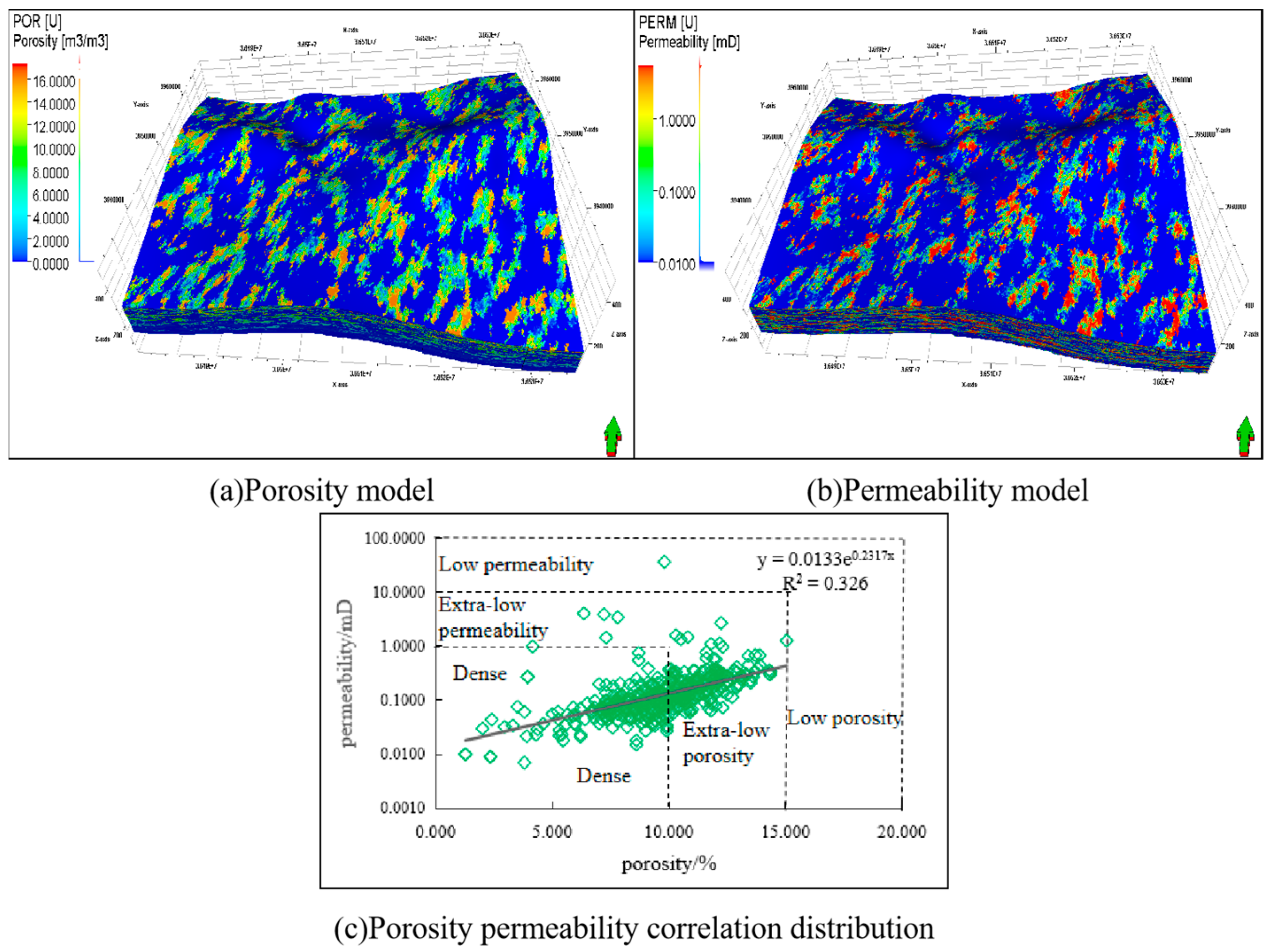
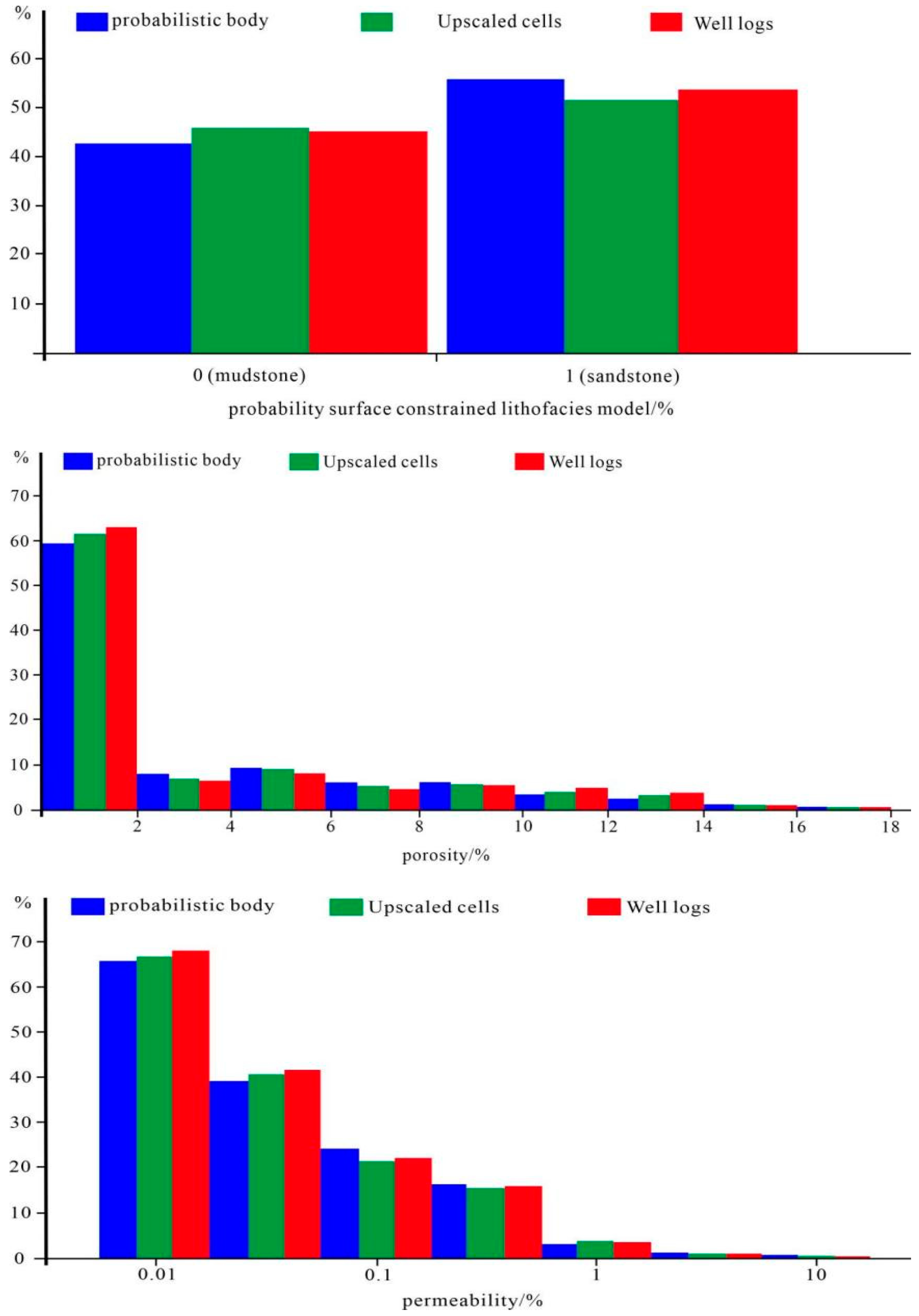
| Sub- Layers | Model | Major Range | Minor Range | Vertical Range | |||||
|---|---|---|---|---|---|---|---|---|---|
| Azimuth/° | Range/m | Nugget/m | Azimuth/° | Range/m | Nugget/m | Range/m | Nugget/m | ||
| Chang 711 | Lithofacies model | 30 | 3200 | 0 | 300 | 1700 | 0 | 4 | 0 |
| Chang 712 | Lithofacies model | 35 | 4000 | 0 | 305 | 2050 | 0 | 5 | 0 |
| Chang 721 | Lithofacies model | 40 | 4500 | 0 | 310 | 2300 | 0 | 6 | 0 |
| Chang 722 | Lithofacies model | 45 | 5100 | 0 | 315 | 2650 | 0 | 7 | 0 |
| Chang 73 | Lithofacies model | 50 | 5500 | 0 | 320 | 3000 | 0 | 8 | 0 |
| Chang711 | Porosity model | 30 | 1300 | 0 | 300 | 750 | 0 | 4 | 0 |
| Chang712 | Porosity model | 35 | 1600 | 0 | 305 | 1050 | 0 | 5 | 0 |
| Chang 721 | Porosity model | 40 | 1900 | 0 | 310 | 1400 | 0 | 6 | 0 |
| Chang 722 | Porosity model | 45 | 2200 | 0 | 315 | 1750 | 0 | 7 | 0 |
| Chang 73 | Porosity model | 50 | 2600 | 0 | 320 | 2000 | 0 | 8 | 0 |
| Chang 711 | Permeability model | 30 | 1200 | 0 | 300 | 850 | 0 | 4 | 0 |
| Chang 712 | Permeability model | 35 | 1450 | 0 | 305 | 1200 | 0 | 5 | 0 |
| Chang 721 | Permeability model | 40 | 1800 | 0 | 310 | 1450 | 0 | 6 | 0 |
| Chang 722 | Permeability model | 45 | 2100 | 0 | 315 | 1700 | 0 | 7 | 0 |
| Chang 73 | Permeability model | 50 | 2400 | 0 | 320 | 2000 | 0 | 8 | 0 |
Disclaimer/Publisher’s Note: The statements, opinions and data contained in all publications are solely those of the individual author(s) and contributor(s) and not of MDPI and/or the editor(s). MDPI and/or the editor(s) disclaim responsibility for any injury to people or property resulting from any ideas, methods, instructions or products referred to in the content. |
© 2024 by the authors. Licensee MDPI, Basel, Switzerland. This article is an open access article distributed under the terms and conditions of the Creative Commons Attribution (CC BY) license (https://creativecommons.org/licenses/by/4.0/).
Share and Cite
Wang, L.; Li, S. Geological Modeling of Shale Oil in Member 7 of the Yanchang Formation, Heshui South Area, Ordos Basin. Appl. Sci. 2024, 14, 6602. https://doi.org/10.3390/app14156602
Wang L, Li S. Geological Modeling of Shale Oil in Member 7 of the Yanchang Formation, Heshui South Area, Ordos Basin. Applied Sciences. 2024; 14(15):6602. https://doi.org/10.3390/app14156602
Chicago/Turabian StyleWang, Linyu, and Shaohua Li. 2024. "Geological Modeling of Shale Oil in Member 7 of the Yanchang Formation, Heshui South Area, Ordos Basin" Applied Sciences 14, no. 15: 6602. https://doi.org/10.3390/app14156602





